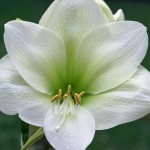As mentioned, amaryllis bulbs grow and multiply over time. Once every few years or so (before they become too crowded) you’ll want to dig them up, separate and replant them. This is also a great time to share with a friend. The best time to do this is in the winter months well before the new growth shows and after the foliage has died back naturally. Do not ever cut the foliage back before it dies back on its own. The plants are creating the seed of next year’s blossoms during this time. To cut the foliage too early is to ensure a spring with few to no amaryllis flowers. Remember to mark the location of the bulbs before the foliage dies back though when you’re planning on digging and separating. The bulbs may be difficult to locate otherwise.
Remove spent flower stalks before seed pods are produced. This is a good idea for the same reason you do not cut the foliage back before it dies back. Plants expend a great deal of energy to produce seed. That is energy they could otherwise use to produce lots of healthy foliage. Allowing the plants to produce seed would interfere with their ability to produce lots of big flowers the next spring. You’d still get flowers—but probably not quite the same pizzazz.
You can also grow amaryllis indoors in soil or water. This is called ‘forcing’ the bulb, and it produces a very striking display that will last for weeks. You will need a forcing jar if you choose the water method. Almost any decorative container that holds water will do as long as it’s large enough to contain the bulb and sturdy enough to stand upright when the plant is in full bloom. They can be top heavy. Using gravel or marbles can add ballast and interest to your display. My favorite containers for this purpose are clear and tall with the bulb nestled in an attractive layer of rocks or marbles in the bottom. Liz will have some bulb arrangements started for the holiday season. They can be purchased, or you can just come see what she’s done before creating your own. The most important thing to remember is to add only enough water so it barely touches the bottom of the bulb. If the bulb sits in water, it will rot. Once the roots grow down into the gravel, keep enough water in the bottom to submerge them; but at this point the level of the water does not have to (and should not) touch the bulb at all. You also want to trim any dead roots from the bulb before creating your arrangement. Leave only the ivory colored, fleshy roots. The dead roots do nothing to support the plant and will rot in the water. Believe me, you do not want your nose anywhere in the vicinity if that happens. Place your arrangement in a bright, warm place. It should bloom within 4 to 6 weeks. Once the flowers open, do not place the jar in bright sunlight. Direct sunlight will shorten the life of the flowers.
To force your amaryllis bulb in soil you will need a pot with drainage instead of a jar. The diameter of the pot should be approximately one inch larger than the diameter of the bulb. Use potting soil that drains well (such as the potting soil we make here at at the nursery), and plant the bulb with one-quarter to one-third of the bulb exposed. Water the pot thoroughly; and place it in a warm, well lit spot. Do not water the plant again until the flower stalk and bud appear. This will usually take two to four weeks. Once you have flower buds, water your amaryllis regularly, but allow it to dry slightly between waterings. As with forcing in water, do not leave your potted amaryllis in direct sunlight once the flower buds have begun to open.
After your amaryllis is done blooming for the season, continue to care for it as the foliage appears and eventually dies back. As with the amaryllis in your landscape, cutting that foliage before it dies back will interfere with the next year’s blossoms. Continue to water your potted amaryllis letting it dry out some between waterings. You want to water it often enough so the bulb remains firm. Protect it from freezing temperatures if you keep it outdoors until the next blooming season. Once the foliage dies back on the bulbs you force in water, remove the bulbs from the forcing jars, dry them and trim the roots leaving only those that are healthy, fleshy and firm. Pack your bulbs in sawdust or some other dry packing material and store in a cool, dry place. Next year you can take them out and start all over again. Or, if you’d prefer, you can plant your potted amaryllis or those you forced in water in your landscape.
In the ground, in a jar or in a pot—amaryllis will bring you a great deal of pleasure (and color) or years to come.











